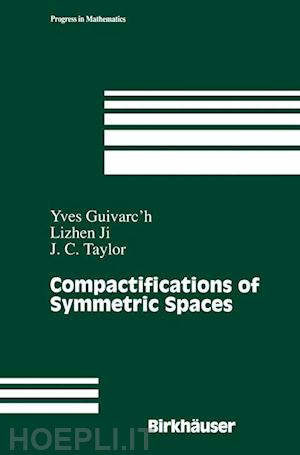
-
DISPONIBILITÀ IMMEDIATA
{{/disponibilitaBox}}
-
{{speseGratisLibroBox}}
{{/noEbook}}
{{^noEbook}}
-
Libro
-
-
SPEDIZIONE GRATUITA
- Genere: Libro
- Lingua: Inglese
- Editore: Birkhäuser
- Edizione: 1998
Compactifications of Symmetric Spaces
guivarc'h yves; ji lizhen; taylor john c.
54,98 €
52,23 €
{{{disponibilita}}}
Disponibilità Normalmente disponibile in 10 giorni
TRAMA
The concept of symmetric space is of central importance in many branches of mathematics. Compactifications of these spaces have been studied from the points of view of representation theory, geometry, and random walks. This work is devoted to the study of the interrelationships among these various compactifications and, in particular, focuses on the martin compactifications. It is the first exposition to treat compactifications of symmetric spaces systematically and to uniformized the various points of view. Key features: * definition and detailed analysis of the Martin compactifications * new geometric Compactification, defined in terms of the Tits building, that coincides with the Martin Compactification at the bottom of the positive spectrum. * geometric, non-inductive, description of the Karpelevic Compactification * study of the well-know isomorphism between the Satake compactifications and the Furstenberg compactifications * systematic and clear progression of topics from geometry to analysis, and finally to random walks The work is largely self-contained, with comprehensive references to the literature. It is an excellent resource for both researchers and graduate students.SOMMARIO
I. Introduction.- Statement of the main new results.- Characterizations of the compactification $${\bar X^{SF}}$$.- The Karpelevi? compactification $${\bar X^K}$$.- Fibers of maps between the compactifications.- Application to Brownian motion.- Eigenfunctions and Martin’s method.- Methods of proof.- Open problems.- Conventions.- Study guide.- II. Subalgebras and parabolic subgroups.- The Iwasawa and Cartan decompositions.- Parabolic subgroups.- Subsets of ? and Lie subalgebras.- The Langlands decomposition of PI and the symmetric space XI.- Bruhat decompositions.- III. Geometrical constructions of compactifications.- The conic compactification $${\bar X^c}$$.- The conical decomposition of a and the Weyl group.- Parabolic subgroups and stabilizers of the points in X(?).- Flats through the base point and Proposition 3.8.- The Tits building ?(G) of G and its geometrical realization ?(X).- The polyhedral compactification of a flat.- The dual cell complex ?*(X).- The dual cell compactification X ? ?*(X).- IV. The Satake—Furstenberg compactifications.- Finite dimensional representations.- Weights and highest weights.- Representation and parabolic subgroups.- Satake compactifications.- Furstenberg compactifications.- V. The Karpelevi? compactification.- The Karpelevi? compactification.- Convergence in the Karpelevi? topology restricted to a flat.- The Karpelevi? compactification of a.- The Karpelevi? topology is compact.- The relation between the Karpelevi? compactification, conical and dual cell compactifications.- A characterization of the Karpelevi? compactification.- VI. Martin compactifications.- The Martin compactification.- Convergence of Brownian motion.- Extension of the group action to the Martin compactification.- The Martin compactification fora random walk.- VII. The Martin compactification X ? ?X(?0).- The Laplacian in horocyclic coordinates.- Generalized horocyclic coordinates and the Laplacian.- Computation of the limit functions: reduction.- The limit of a CI-canonical sequence.- Classification of limit functions and the topology of X ? ?X(?0).- VIII. The Martin compactification X ? ?X(?).- The case of X = SL(n, ?)/SU(n) for ? < ?0.- Computation of the limit functions for a general semisimple group.- Determination of the Martin compactification.- Bounded harmonic functions on X.- An application to convergence of Brownian motion.- IX. An intrinsic approach to the boundaries of X.- The space of closed subgroups.- Limit groups.- Limits of group spheres.- Parabolic subgroups and boundary theory.- The maximal Furstenberg compactification.- X. Compactification via the ground state.- The twisted action.- Compactification of X via the ground state.- XI. Harnack inequality, Martin’s method and the positive spectrum for random walks.- Basic notations.- Cones with compact bases and the Harnack inequality.- Martin’s method for a random walk.- The positive spectrum of a random walk.- The fixed line property.- Formulas for r(p),r0(p).- Outline of the following chapters.- XII. The Furstenberg boundary and bounded harmonic functions.- Basic notations.- The mean-value property.- Harmonic functions and the mean-value property.- Convergence theorems for harmonic functions.- The Poisson formula for random walks.- XIII. Integral representation of positive eigenfunctions of convolution operators.- The main result of this chapter.- An extension of the main result.- Analytic determination of the minimal eigenfunctions of the Laplacian.- The Busemann cocycle and a geometrical determination of theminimal eigenfunctions of the Laplacian.- Minimal eigenfunctions for random walks.- XIV. Random walks and ground state properties.- Basic definitions and properties.- Convolution.- Spherical functions and minimal eigenfunctions.- Ground state properties.- Random walks, eigenfunctions of the Laplacian and X ? ?X(?0).- The Martin compactification of X determined by a random walk.- An application to parabolic subgroups.- XV. Extension to semisimple algebraic groups defined over a local field.- Some notations and fundamental properties.- Extension of the main results of Chapters XII, XIII, XIV.- Appendix A.- Appendix B.- List of symbols.ALTRE INFORMAZIONI
- Condizione: Nuovo
- ISBN: 9781461275428
- Collana: Progress in Mathematics
- Dimensioni: 235 x 155 mm
- Formato: Brossura
- Illustration Notes: XIII, 286 p.
- Pagine Arabe: 286
- Pagine Romane: xiii
